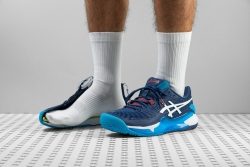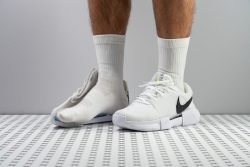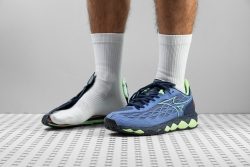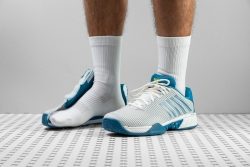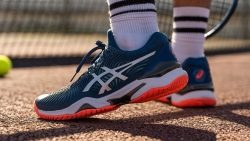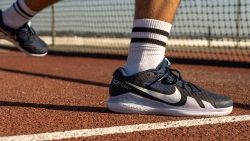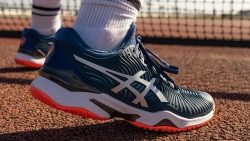7 Best Hard Court Tennis Shoes in 2024

Picking the right high-performance tennis shoes designed to take the abrasiveness of concrete can be daunting. So, to get the load off your back, we did the playtest for you and analyzed every nitty-gritty detail of hard court tennis shoes from the much-sought labels.
Whether you're in search of light and speedy ones, or something more cushioned and supportive, or even the most affordable hard court tennis shoes, you came to the right pod. We have all the best in these categories featured here.
How we test hard court tennis shoes
- We don't take free shoes from the brands or let advertisements influence our selection of top picks. We purchase every pair of tennis shoes using our own money to give unbiased reviews.
- We spend no less than 12 hours a week playtesting and scrutinizing the shoes based on several parameters, including comfort, breathability, weight, arch support, stability, outsole durability, traction, toe strength.
- We measure the different parameters of the tennis shoes including durability. For this test, which we refer to as the Dremel test, we apply a drill with various attachments to the shoe's upper. From there, we observe how distressed it is from the abrasion. Not only that but we also split the shoes in half to get a bigger picture of what compose the interior.
The combined analysis helps us come down to the top choices.
Best hard court tennis shoes overall
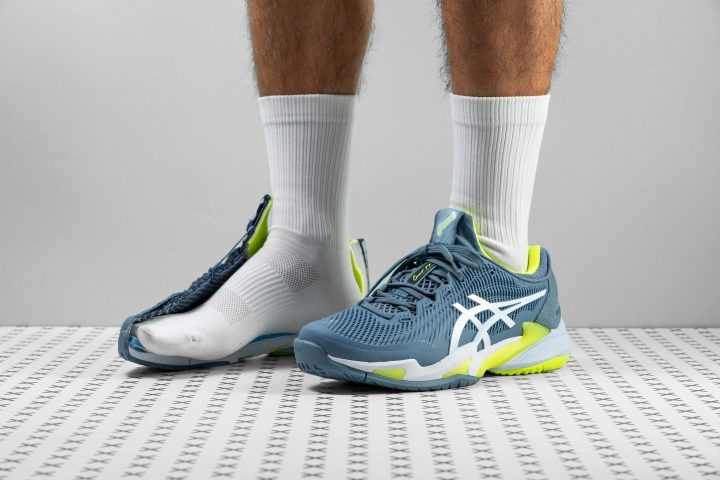












































What makes it the best?
The tennis shoe that remarkably confronted the unforgiving surface of hard courts during the multi-hour wear tests we performed is the ASICS Court FF 3. Every skid, slide, shift, and halt in this shoe couldn’t be more effortless and risk-free.
What kept us planted on the hard court despite agile movements was the rigid heel counter. This checked out with the subjective assessment we did for the heel counter. It endured our pinching and twisting, gaining a score of 4/5 in stiffness.
With grip, we are hands-down impressed. We found the ripple design of the outsole is really effective in keeping us in control of our sideway actions. We also gauged the hardness of the outsole using our durometer to be 85.3 HC, which is around the average outsole hardness and only 2.2% softer. In our games, this ensured both outstanding traction and robustness.
The toughness of the outsole of Court FF 3 was also apparent in our actual games. After hard-core tennis playing, the outsole showed no sign of wear and it remained intact. Additionally, our Dremel only caused a shallow 0.4 mm cavity on the outsole, which is right around the average. However, we would still find it more comforting to know that it has a durability guarantee, except it doesn’t. So, if this is one of your requirements in tennis shoes, we advise skipping Court FF 3.
Pros
- Top-notch abrasion resistance
- Excellent impact protection in the heel
- Responsive and propelling cushioning
- Unmatched foot containment
- Exceptionally stable platform
- Fantastic grip and sliding
- Very comfortable in-shoe feel
Cons
- Lacks breathability
- Not for wide feet
- High price
Best tennis shoes for speed
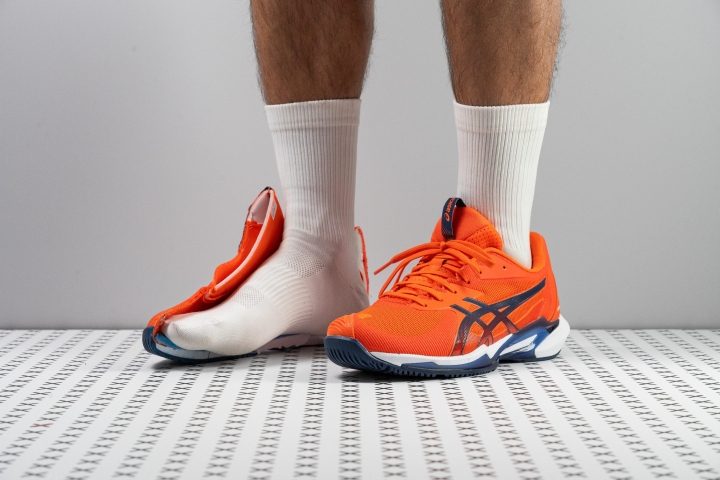














































What makes it the best?
Solution Speed FF 3 lives up to its name as the ultimate speed tennis shoe for hard courts, offering agility and responsiveness for dynamic movements. We can effortlessly keep up with this demanding sport, as our lab confirms the exceptional control, grip, and durability the shoe brings for peak performance.
The shoe feels barely there during our matches, with its ultralight 10.9 oz (309g) build. Other than its weightlessness, the responsive FlyteFoam cushioning provides solid ground connection, allowing us to move in a quick and agile manner. Our durometer reveals the foam is a balanced 31.5 HA, enhancing stability and propulsion in our strides, together with the Speedtruss shank that adds stiffness to the right areas.
The Precision Sole delivers reliable traction, keeping us surefooted through sudden direction changes and micro-adjustments. Our durometer reveals its durable 84.0 HC outsole, which aligns with our experience since the shoe looked pristine after extensive testing.
Remarkably, the shoe withstands friction from all angles, with its toebox and heel earning perfect 5/5 ratings in durability. Despite its durability, the upper maintains breathability, earning a perfect 5/5 rating. This solid combination is extremely rare, but Solution Speed FF3 made it happen.
However, players with wide feet may find the narrow forefoot uncomfortable. Best to check shoes with a more accommodating fit.
Pros
- One of the lightest tennis shoes on the market
- Fantastic wear resistance and durability
- Exceptionally breathable for a tennis shoe
- Grounded platform with a great court feel
- Shank adds propulsion and facilitates speed
- Rockered heel makes transitions faster and smoother
- Solid stability for a speed-oriented shoe
- Perfect grip with enough give
Cons
- Not for wide feet
- Not very stable for baseline players
Hard court tennis shoes with the best stability
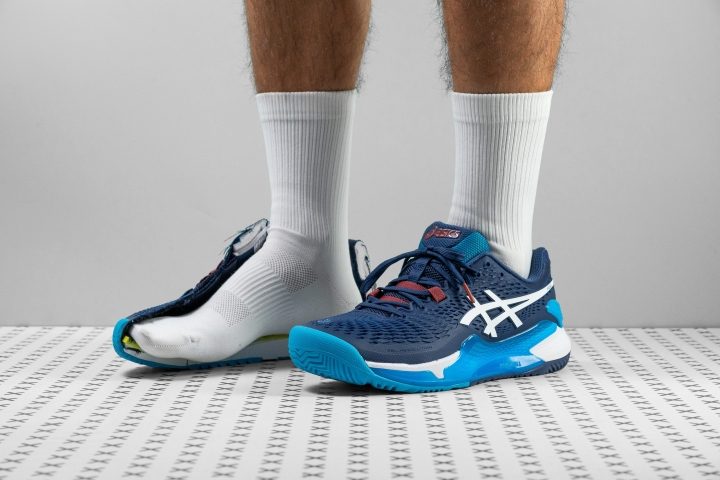











































What makes it the best?
The results of our lab assessments pointed to the ASICS Gel Resolution 9 as the most stable hard-court tennis shoes. Both its torsional rigidity and heel counter clasp were perfectly designed to deliver amazing stability. This tennis shoe also delivered high levels of durability from top to bottom.
We assessed the Gel Resolution 9 by bending and twisting it using our bare hands. We have to say, this one was quite difficult to handle. It resisted our maneuvers so well. Hence, we gave it a perfect 5 for both torsional rigidity and heel counter stiffness. These two contributed so much to the surefootedness that we experienced while wearing this ASICS shoe on the court.
The toebox was also scored a perfect 5 for durability. We Dremel-drilled it for twelve seconds, but no significant damage was seen. Actually, there was barely a dent. Given such results, we were confident that this shoe could really take some serious beating.
The outsole also displayed high levels of durability. We pressed our widely rotating Dremel against it, and the resulting dent was only 0.4 mm deep, which is far less than the 0.7 mm that we would have seen in the average outsole.
At 13.86 ounces or 393 grams, the ASICS Gel Resolution 9 was slightly heavier than average, which only registered 12.84 ounces or 364 grams on our weighing scale. The added weight was not a deal-breaker, but it was a serious drawback nevertheless.
Pros
- Immensely stable and supportive
- Highly secure foothold
- Unbeatable durability
- Amazing impact protection and responsiveness
- Incredible in-shoe comfort
- Provides arch support
- Excellent grip but can slide as well
Cons
- Slightly heavy
- A little break-in needed
Hard court tennis shoes with the best energy return
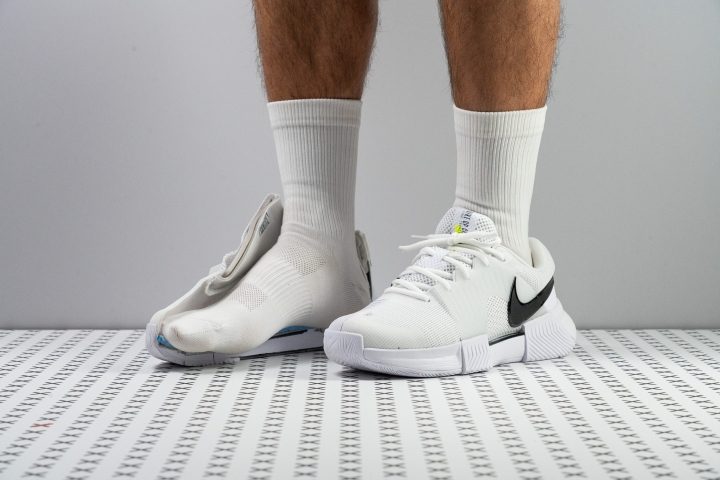
















































What makes it the best?
When the conversation turned to energy return, we could not think of anything else besides the Nike Zoom GP Challenge 1. This shoe’s Zoom units just delivered impressive amounts of energy return, fueling our side steps and forward lunges on the court. We were also impressed by this shoe’s twist resistance and amazingly secure heel clasp.
We could say that the Zoom GP Challenge 1 had energy in its DNA. Aside from the Zoom units, the shank embedded in its midsole also provided high levels of springiness that undoubtedly enhanced the efficiency of our steps.
Foot twists are painful, and we would want to avoid it as much as possible. Good thing that the base of this Nike tennis shoe was stiff and twist-resistant. We gave it a good twist in the lab, and elected to give it a perfect 5 for torsional rigidity.
The heel counter also contributed a lot to our surefootedness. It securely embraced our rearfoot, giving no space for wobbles and other forms of instability. The 4 out of 5 that we gave the heel counter for its stiffness was pretty much well-deserved.
The weight of this shoe, though, could still be improved. At 14.71 ounces (417g), the Nike Zoom GP Challenge 1 was a lot heavier than the average tennis shoe which would weigh only 12.84 ounces (364g).
Pros
- Excellent lateral support and stability
- Highly responsive and bouncy cushioning
- Great impact protection
- Stiff shank adds lots of propulsiveness
- Rockered heel makes heel-to-toes smoother
- Very durable and thick outsole
- Cozy step-in feel
Cons
- Heavier than average
- Not enough protection for toe drags
- A bit fiddly tongue
Hard court tennis shoes with the best cushioning
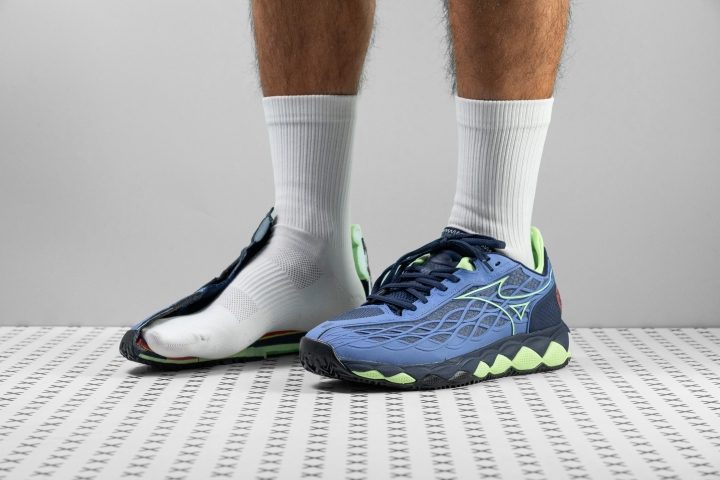













































What makes it the best?
After seeing the results of our lab assessments and on-court tests, we did not hesitate to declare the Mizuno Wave Enforce Tour as the hard-court tennis shoe with the best cushioning. Its cushioning was thick, especially beneath the heel, allowing it to ensure comfort. We were also in awe of how stable it was as a function of its wide heel platform and noteworthy torsional rigidity.
Through our caliper measurements, we discovered that the midsole of the Wave Enforce Tour had more material than the average. Its heel stack was as high as 33.0 mm when the average was only 29.3 mm. The additional material helped in keeping us comfortable even during intense rallies.
Instability was a common issue with shoes with thick midsoles. Fortunately, this was not the case with the Mizuno Wave Enforce Tour. This tennis shoe had a pretty wide platform, especially its heel. While the average heel width was 89.7 mm, the heel width of this Mizuno tennis kick was as high as 99.7 mm.
Besides having more platform area, the shoe was also quite resistant to twists. We manually bent and twisted it in the lab, and making it yield required a lot of effort. It surely earned the 4 out of 5 that it got for torsional rigidity. Fair and square.
The heel padding, though, could have done better. It was destroyed after just a few seconds of Dremel drilling. We scored the Mizuno Wave Enforce Tour's heel padding the lowest 1 out of 5 for such a dismal performance.
Pros
- Fantastic impact protection
- Responsive cushioning
- Doesn't drag the foot
- Comfortable even after long sessions
- Great stability
- Super grippy
- Amazing lockdown
Cons
- Not for narrow feet
- Upper lacks durability
Best budget hard court tennis shoes
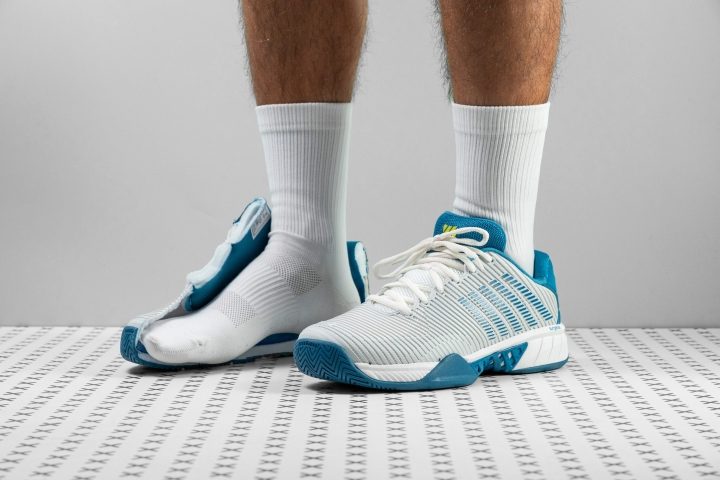












































What makes it the best?
Claiming victory in the best budget section of hard-court tennis shoes is the K-Swiss Hypercourt Express 2. Because of this affordable yet marvelous pair, we are spared from the joint stress and pressure caused by playing on hard courts. It’s valued at $110, which we discovered to be 13% more affordable than the typical tennis shoes.
We were able to move with ease in all directions and the fantastic tread made it possible. No incidents of tripping and slipping occurred when we were sporting the Hypercourt Express 2, which speaks volumes given that we performed quickly on our feet.
Despite the shoe’s economical price and after being abused on hard courts, we didn’t detect any thinning out or decline in quality in the outsole. Bonus is it’s also non-marking. Unfortunately, we discovered that narrow footers might not fully enjoy it due to its roomy fit. We suggest either sizing down or going for a snugger pair.
Pros
- Light and nimble on the feet
- Mind-blowing durability for the price
- Well-balanced soft cushioning
- Wide and stable platform for a speed shoe
- Excellent grip and give
- Amazing in-shoe comfort
- Ideal for wide feet
Cons
- Lacks breathability
- Not for narrow feet
Best hard court tennis shoes for beginners
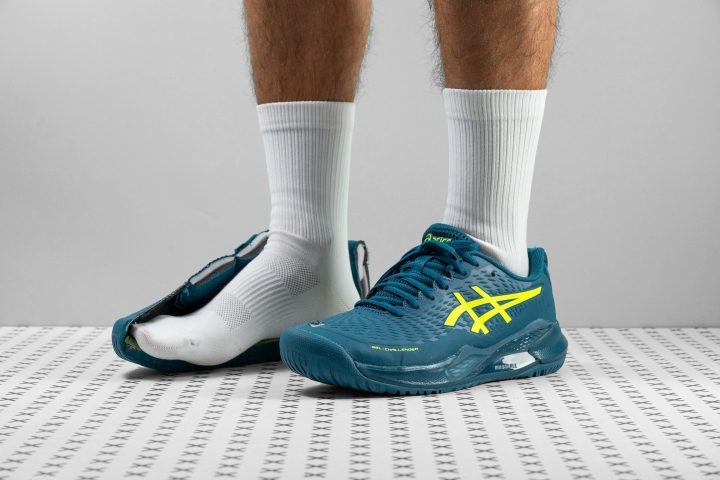










































What makes it the best?
Following our extensive testing of tennis shoes, we concluded that the ASICS Gel Challenger 14 is the most suitable pair for beginners playing on hard courts. This tennis shoe didn’t fail us with its incredible traction that clung firmly to the surface plus its supportive confines that rendered us stable footing through our quick direction changes.
During our games, we moved inside the hard court without a trace of worry because of ASICS Gel Challenger 14’s amazing grip. In our lab, we found that its outsole is almost as hard as the average at 86.5 HC, preventing unwanted slips while playing.
We also manually evaluated the torsional rigidity (5/5) and heel counter stiffness (4/5) of the ASICS Gel Challenger 14. We discovered that the shoe wasn’t easily swayed by our twisting while the heel didn’t surrender from our pinching. This led to superb balance and reduced risks of ankle rolls during lateral movements and sprints.
ASICS Gel Challenger 14 did not respond well to toe dragging, though. We pressed our Dremel against the shoe’s toebox and the chafing it caused earned the upper durability a 3/5 score. If you wish for something more hardwearing, we suggest exploring other alternatives.
Pros
- Excellent stability and arch support
- Super hard-wearing outsole
- Grip of a top-tier tennis shoe
- Light for a stability-oriented shoe
- Lots of impact protection
- Plush and cushy in-shoe feel
- More flexible than average
Cons
- Lacks breathability
- Upper is not so abrasion-resistant
Unforgiving. Fast paced. Dynamic. Relentless. Demanding. Competitive. Powerful… Welcome to the world of hard court tennis; a sport where split-second decisions and slick movements can be the difference between victory and defeat. With that in mind, it will come as little surprise to even the beginner hard court tennis player that the correct shoes are crucial.
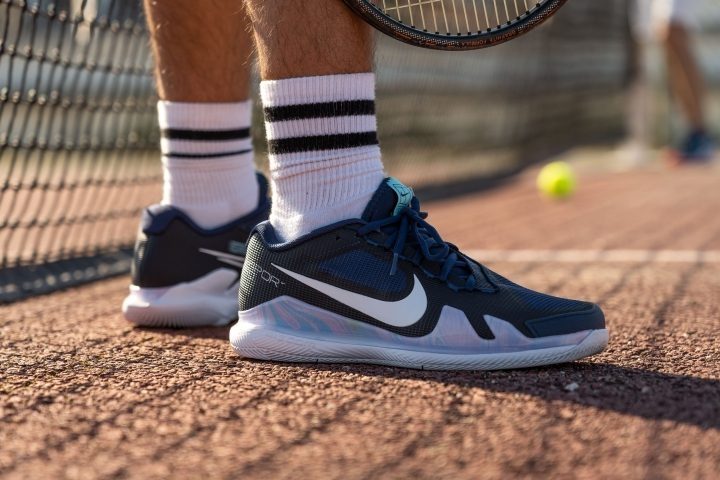
So if you’re looking for the best tennis shoes for hard court playing surfaces you’ve come to the right place. It’s time to set aside your racquet momentarily and turn your attention over to considering the significance of your footwear choice.
Understanding the characteristics of a hard court
Before we look at the shoes, we must first understand the surface the shoes are designed for. Hard courts are arguably the most popular of the tennis court types and are also the most commonly played on surfaces, not only amongst amateurs but also on the professional tennis tour.
A surface for everyone
Hard courts are made out of an asphalt or concrete base that is coated with different materials and therefore can be seen in a range of colors, green and blue being the most common. From a distance the surface appears silky smooth but up close it is rather abrasive. Most hard court tennis shoes are white in appearance, but this type of surface can accommodate any color.
Speed: It’s fast!
Hard courts are generally considered fast because the ball moves significantly quicker on a hard court than on a clay court, but not as fast as a grass court. Your shoes will need to be able to support your quick reactions accordingly.
Predictable ball movement
The ball bounce on a hard court is high but consistent, with less spin than clay courts, but more so than grass courts. This combination makes it easier to predict the ball’s trajectory and therefore makes it popular for beginners just learning how to play tennis right through to professionals training for an up-coming tournament.
Easy maintenance
Many local tennis clubs, large and small, enjoy the benefits of hard courts for their long-term durability, versatility and ability to keep clean and maintained easily. Likewise for your shoes; hard court tennis shoes are known as the easiest to maintain.
Harsh impact
While clubs benefit from such a durable surface, players need to be wary - hard courts can be relatively harsh on the body as the surface does not absorb impact as much as clay or grass. This is where a good choice in footwear, ideally a pair of hard court specific tennis shoes - pays dividends.
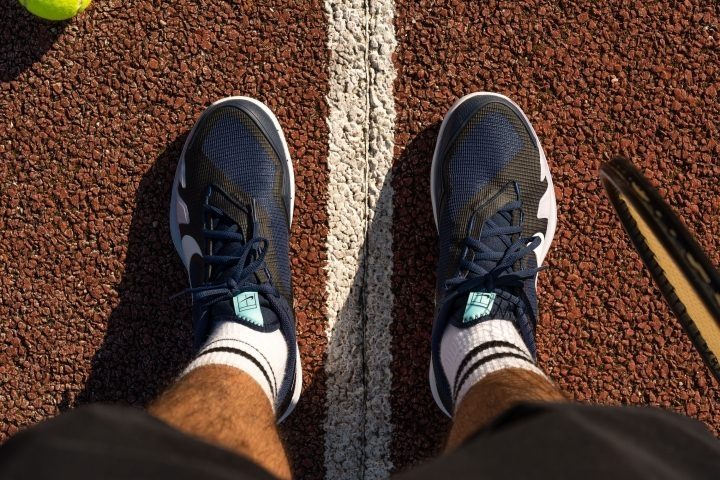
What do we mean when we say hard court tennis shoes?
The design of hard court tennis shoes is tailored to withstand the demands of the dense playing surface. In recent years manufacturers have made it easier to identify hard court tennis shoes by either using the term “hard court” in the product name or using the corresponding “HC” acronym.
If hard courts are your primary playing surface, ensuring your shoes possess the specific design elements to withstand the rigorous demands of this court type becomes crucial.
9 key elements to look for in hard court tennis shoes
Now that we understand what a hard court is and what the corresponding shoes are, it’s time to get into the fun stuff - what details in hard court tennis shoes should you be looking for?
1. Comfort and fit: This should go without saying (but I’ll say it anyway): properly fitting tennis shoes are crucial to your game, and in fact, this is the most important priority when shopping for a pair of hard court tennis shoes. They should fit snugly without being too restrictive, thus allowing for natural food movement during fast and dynamic play.
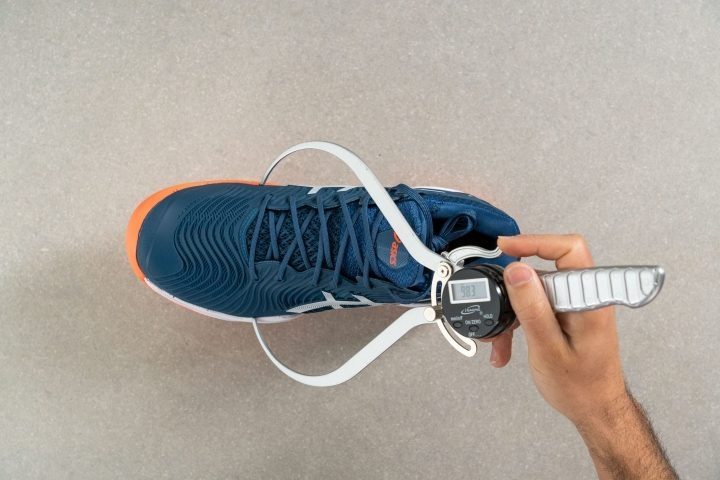
2. Durability: Given the abrasive nature of hard court surfaces, the shoes you wear must withstand the constant pounding and friction encountered during gameplay. Footwear manufacturers are aware of this and as such have introduced durable materials to their products such as reinforced uppers, sturdy outsoles, and hardy stitching.
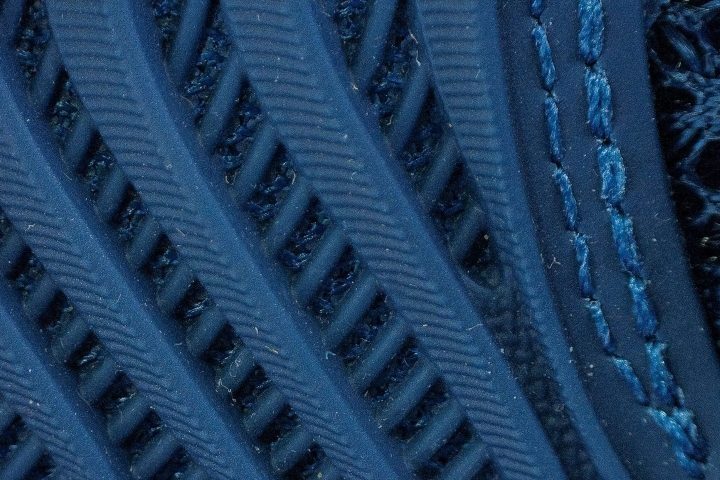
The upper should be resistant to wear and tear and the outsole made of hard-wearing rubber compounds designed to endure the harsh impact of hard courts, at the same time providing long-lasting traction.
Additionally features such as outriggers and toe guards will protect against scuffs and abrasions while maintaining their structural integrity.
3. Traction: The ability to grip the surface effectively is essential for quick movements and sudden directional changes in tennis. Look for shoes with an outsole designed specifically for hard court playing surfaces; most often they feature a modified herringbone pattern which is effective at providing multidirectional traction, designed to avoid slippage.
Tennis shoes with good traction will help ensure stability while preventing injury, giving you the confidence to maneuver on the demanding hard court surface.
4. Cushioning: Cushioning plays a vital role in hard court tennis shoes, as the unforgiving nature of the surface can lead to increased impact on muscles and joints. Look for cushioning primarily in the midsole to act as a shock absorbent, and consider technologies such as foam or gel cushioning systems that are responsive and supportive.
But be aware - too much cushioning can take away the ‘feel’ of the court, which is something many players will not appreciate because they seek to immerse themselves into their surrounding conditions thus making reading the ball and general play much clearer.
But for other players maximum impact protection is key and they will prioritize additional cushioning. Ultimately we recommend that you find your balance, what works for you, and roll with that.
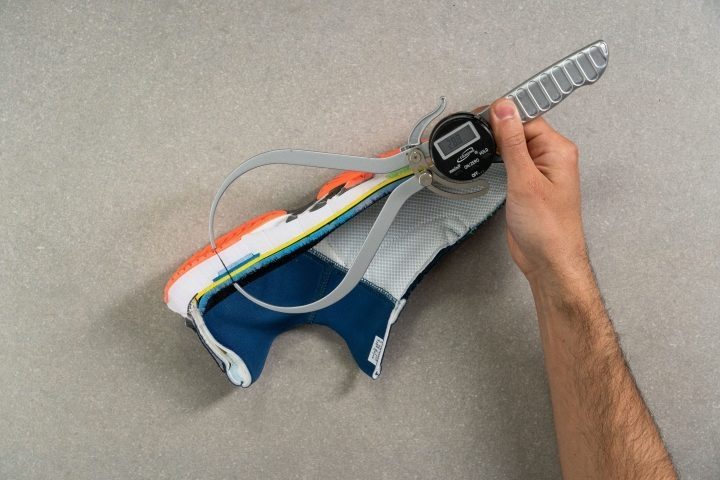
We use a caliper to measure both heel and forefoot stacks of our lab-tested tennis shoes.
5. Stability: Shoes act as the very foundation of your tennis playing time and therefore it’s important to consider how much security and stability they would offer you.
Look for characteristics such as a sturdy upper construction that ‘locks’ the foot into place and prevents excessive internal movement, particularly side-to-side. Consider shoes that are made of sturdy synthetic uppers, reinforced with overlays or panels that offer lateral support.
Heel counters and secure lacing systems also contribute to stability and mentally assist the player with the feeling of being safe and secure in their footwear.
6. Lightness and breathability: The combination of lightweightedness and breathability in hard court tennis shoes can significantly impact your on-court performance and overall comfort. For a hard court tennis player, lightweight shoes reduce the burden on your feet and legs, enabling faster movements and quicker reaction times. If you’re a player who likes to remain nimble and fast on the court, this will appeal to you.

Meanwhile, breathability maintains a cool and dry internal shoe environment which then helps prevent an issue sometimes coined as “hot foot syndrome” - a temporary but annoying problem identified by excessive foot sweat and sore foot arches which can later lead to blisters and stinky odor.
Shoes that are made with mesh or perforated uppers will enable airflow and therefore heat to escape and moisture to dry. Tennis is a summer sport and keeping cool is an important priority for many players.
7. Arch support: The level of arch support a shoe offers directly influences foot alignment which is critical during swift lateral movements and fast accelerations around the court. Additionally, it ensures reduced fatigue and strain on the feet, ultimately allowing you to enjoy your playing time and maximize your tennis potential.
A player with high arches should look for shoes with pronounced arch support to prevent overpronation (inward foot roll) and evenly distribute pressure across the foot. On the contrary, a player with low arches should seek shoes designed with additional arch cushioning to support correct foot alignment.
8. Toe reinforcement: Toe reinforcement provides protection and additional durability against the wear caused by fast and aggressive on-court movements during a game of tennis. The constant footwork and abrupt stopping on a hard surface can cause your shoes to deteriorate, in the form of scuffs and abrasions, at a greater speed than regular sneaker wear.
This is especially so if you’re the type of competitive player who finds themselves running fast at the net or sliding across the court to make that forehand shot. If you consider your shoes to be an investment in your tennis you’ll want to take advantage of a pair of tennis shoes with toe reinforcement, otherwise, they can become a liability which will require frequent replacing.

To identify a pair of tennis shoes with toe reinforcement look for terms such as ‘toe guard’, ‘toe cap, or ‘reinforced toe’ within the online product description. Alternatively, you can see the photos - visually look for the extra protective layers around the toe area.
An example of a shoe with this feature is Nike’s Court series of shoes, each with very obvious toe reinforcement stitched into the shoe itself.
9. Brand and ranking: Of course, it’s nice to wear shoes from a brand that you can identify with, and likely you chose that brand because they’re known for their consistent quality and performance. Appealing brands go a long way in the decision-making process and Nike, Asics, Adidas, and New Balance are all great brands that make great hard court tennis shoes.
To really nail your research, you should also look at the online reviews from people who have actually worn those shoes and experts who have taken it that further step. At RunRepeat, we also lab test shoes with specialist equipment to really get into the hardcore details. Who else literally cuts shoes in half to analyze how good they might be? Read more about our testing methodology here.
The quest for the perfect hard court tennis shoes
At some point throughout this article, you may have found yourself internally questioning what is seemingly conflicting information as to what’s right for you. To explain further, the wide variety of quality hard court tennis shoes available on the market means that some brands and models will focus on one thing, therefore making another characteristic implausible.
The dilemma
For example, if you want a fast shoe, the lightweight nature of that shoe might mean that you find yourself needing to compromise on durability (or vice-versa, as the case may be).

Likewise for stability: some players will prefer their hard court tennis shoes to have a more neutral design to allow better freedom of movement, while others will opt for the more stable version to accommodate their desire to keep their range of foot eversion limited.
If you look for perfection, you'll never be content
Which brings me to my final point; there is no such thing as the perfect hard court tennis shoes. Don’t get me wrong, there are some brilliant options out there - but to say a particular shoe is ‘perfect’ is an oxymoron in itself; there’s always a compromise somewhere - there has to be.
The key lies in assessing your playing style and specific needs in order to find hard court tennis shoes that suit you best. By understanding what type of player you are and considering what you really need, you might just find the perfect hard court tennis shoes available… for you. After all, that’s all you can do.
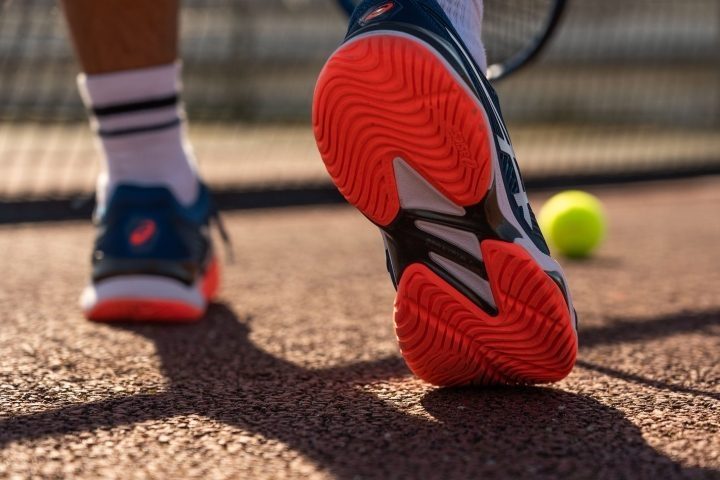
Frequently asked questions
Can I wear hard-court tennis shoes on grass?
Hard court tennis shoes are often regarded as those that suit a neutral playing surface, striking a balance between clay and grass courts in terms of responsiveness in relation to ball bounce and court speed.
This adaptability caters to a wide range of playing styles, accommodating both fast and powerful players who find themselves on equal footing. And while one pair of shoes for all court surfaces is perfectly fine for beginners and social players, competitive players will definitely benefit from the attributes that each of the court-specific shoes offers.
Can I wear running shoes on the tennis court?
Yes, running shoes can be utilized effectively for tennis, particularly for beginners who are trying out the sport without investing in specialized tennis shoes. While running shoes lack the specific lateral support found in tennis shoes, they can still be suitable for casual play and may not significantly impact your performance, especially if you're just starting.
For more competitive or regular tennis players, investing in proper tennis shoes with dedicated lateral support is recommended for enhanced performance and injury prevention.



